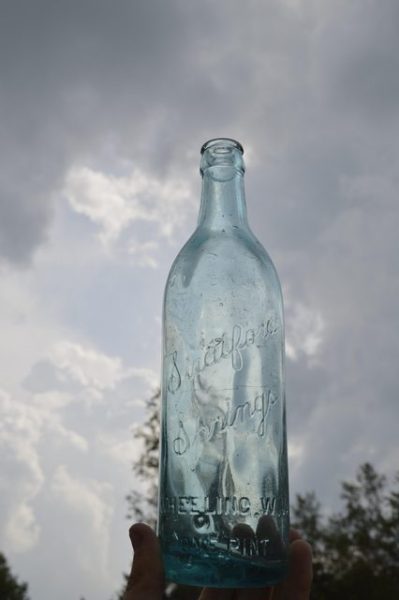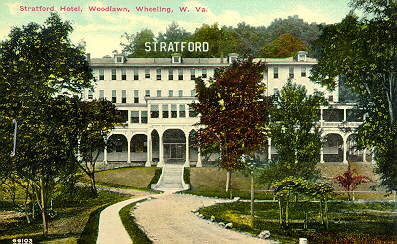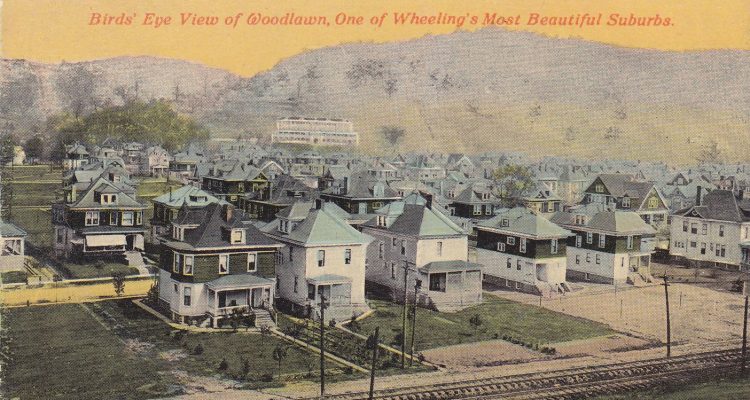My interest in the Stratford Hotel began as a young girl. It was there I played hooky from piano lessons, picked wildflowers and earned my Girl Scout trailblazing badge.

One day I found silverware and shards of plates that said “Stratford Springs Hotel” on them. I have since discovered that the china used at the hotel was made by Homer Laughlin China, but their records were lost in a fire so they were unable to tell me anything about the china. But I never lost my interest in the hotel, whose grandeur and mystery has intrigued me to this day.
The hotel was built in 1903 on what is now Edgwood Street in Woodsdale. The former owner of the land was aware of the many springs on the property and had sold the waters that he bottled himself. At that time, going to “take the waters” was a very sociable thing for society to do and many resorts had grown up around mineral springs. This is how Saratoga Springs in New York State got its start and later Greenbrier in the Southern part of West Virginia. The Greenbrier was not yet a year-round resort and difficult to get to and Saratoga was not centrally located enough, so the Stratford became a real drawing card for society to gather and imbibe in the brisk, sparkling, and acidulous waters from the springs.

West Virginia has a large percentage of the 250 mineral springs found in the United States and reputed to have medicinal properties. Among other ailments they propose to cure anemia, chlorosis, dyspepsia, chronic cachexiae, gout, diabetes, leucorrhoea, and chronic diarrhea. They increase the appetite, improve digestion, give increased cardiac action, and improve the quality of the blood, particularly in anemic individuals. It is also claimed that they prevent kidney and gall stones, help a sluggish liver, and cure hemorrhoids, rheumatism, and syphilis, but their most important curative power was in their ability to regulate moods. In this they were the equal of the best of European springs at Vichy (France) and Seltzer (Germany).
None of the many springs at Stratford were thermal springs. They maintained a constant temperature of 55 degree Fahrenheit year round, so to get their benefit one had to drink this bubbly concoction daily. The springs were naturally carbonated, so this was the “soda water” of the day.
When completed in 1907, the hotel was a block long and three stories high with 84 rooms, a spacious lobby, two dining rooms, several sweeping verandas, three sun parlors, a tennis court, pool, and a billiard parlor. Modern conveniences included a telephone in each room and a power plant for electricity generation on the site.
The dining room seated 300 and the meals were elegant. A six-course meal costs $0.75 and the Assembly hall served for conferences and conventions and was used as a ballroom.
The sitting room or sun parlor was a particular favorite of patrons. The hotel described it as follows:
“Sitting in the beautiful Sun Parlor, one is struck by the color of the windows as the shadows of twilight begin to fall. Whether it be a reflection of the surrounding hills, or just some unexplained phenomenon for the contemplation of science, the windows take on a deep blue tinge, and fill the room with a soft and soothing radiance, like the light of dreamland.”
The Stratford Hotel was the site of dancing lessons, bridge clubs, luncheons, dinners, and numerous other social occasions. There was even a luncheon for the WVU football team. But it was most famous for its masked balls usually held twice a year at Easter and Christmas. Young society women acted as the hostesses at these “living kaleidoscopes” and the ball began with a procession at 9pm when the charge d’affairs ushered the patronesses into the dining room followed by the guests. The ballroom glittered with magnificent decorations appropriate to the season and only the best orchestras were contracted.
The local gentry soon decided tat living at the hotel during the winter was cheaper and easier than keeping a staff and heating their mansions. The rates were $12.50 to $15 per week for a suite or $3 per day. Meals were served and many of the occupants brought their own furnishings from home.
The Wheeling Intelligencer, “The Stratford was beautifully located near the foot of Woodlawn hill and nestled in a perfect bower of trees and shrubbery that made it a beautifully cool and sequestered spot during the sultry days of midsummer. The hotel was abundantly supplied with sweeping verandahs its whole length and sides, together with roomy sun-parlors admirably adapted for living room purposes during the winter months.” Since so many out-of-towners stayed at the hotel, this was also an ideal place for society debs to meet future mates.
In the early hours of the morning on January 13th, 1918 a spark from a gasoline engine in the ice department set waste nearby on fire and spread to ammonia tanks causing them to explode. The fire quickly spread to a nearby linen storage room and was soon out of control.
The wind was blowing strongly from the West and since the fire started in the northeast corner of the hotel, the flames had to struggle against the brisk wind, which prevented the conflagration from moving more quickly against the all-wooden structure. Fire departments from Woodsdale, Edgwood, and Wheeling responded with pumper trucks, but as the night was so cold, the water soon froze over the structure making a “toboggan slide of the front porch” which enabled the firefighters to slide grand pianos, safes, ornate mirrors, velvet couches, precious rugs, and patrons down the slippery slope.
The residents of Woodsdale took the bedraggled guest, most in their nightclothes and bare feet into their homes and provided warm drinks for the firefighters. The flames were bright enough to be seen in downtown Wheeling that night, but no lives were lost. The next morning’s paper reported the locations of all of the guests most of whom had moved to other hotels in the city.
The building was underinsured and was a total loss. It was never re-built because of increased building costs. The total loss in property, furnishings, and personal property of the guests was estimated at $150,000. There were 125 guests at the time of the fire.
The Stratford Springs Hotel, the grand dame of the turn of the century resorts, was sorely missed by the social set of Wheeling. Its history as a “pillar of beauty” should be remembered.
Editor’s Note: This story originally appeared on Mike Quinn’s blog, Kadizzled. He has generously agreed to look the other way while we pilfer his material that pertains to Wheeling. A note from Mike regarding this story:
This article is written by my sister Kate, this resort at one time existed close to the home I grew up in.


